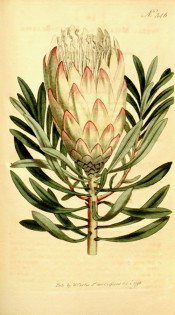Protea repens L.
Half hardy, erect, bushy shrub or small tree with lance-shaped leaves, to 15cm long, and goblet-shaped flowers heads, to 9cm across, uniformly cream-white or tipped with pink or red, and covered with sticky resin, in spring and summer. To 4m. [RHSE, Hortus].
Horticultural & Botanical History
‘To a magnificent appearance, the blossoms of the Protea joins a structure extremely curious and interesting; but, at the same time, difficult to be understood by students, who are apt to consider the whole as one great simple flower, while in reality it is composed of a number of florets enclosed within a common calyx formed of numerous leaves or scales placed one over the other, and fitting on one common receptacle, being in fact what Botanists term an aggregate flower, approaching indeed near to a compound one, there being in the structure and union of the antherae a considerable similarity to those of the Syngenesia class, much more so than in the flowers of Plantain, Scabious, Teasel, and others. […] This magnificent shrub, a principal ornament of the Cape-House at Kew, is a native of the Cape of Good Hope, from whence it was introduced by Mr. Masson, in 1774 (Ait. Kew.); it flowers chiefly in the Spring, and often during the Summer; is propagated principally by layers. Our drawing was made from a plant raised from Cape seeds, which flowered this season, among a number of others equally curious, in the collection of Mr. Barr, Nurseryman and Florist, near Ball’s-Turnpike, Kingsland.’ [BM t.346/1796].
Andrews’ Botanical Repository figures Protea mellifera albiflora, a variety introduced by the Duke of Northumberland at Sion House c.1807. [ABR pl.582/1809].
History at Camden Park
Listed in all published catalogues [T.778/1843].
Notes
Published Mar 21, 2010 - 03:14 PM | Last updated Mar 21, 2010 - 03:19 PM
| Family | Proteaceae |
|---|---|
| Category | |
| Region of origin | South Africa |
| Synonyms |
|
| Common Name | Sugarbush |
| Name in the Camden Park Record |
Protea mellifera |
| Confidence level | high |


